|
Recreated from Caraval by Stephanie Garber Scarlett tried to ignore it as she inched closer. Next to the clothes, on top of a gilded table covered in moon dials, a curvy vase of red roses sat next to a tray laden with fig bread, cinnamon tea, and a note. Cross-sensory trickery in Stephanie Garber’s Caraval includes smelling colours, feeling flavours and hearing food. This is a realm of unexpected metaphors, where food serves as a medium between unusual experiences and our protagonist’s perception of them: the colour plum triggers olfactory associations of brutality for her; discomfort is experienced as the prickling of smoky-ginger; and in one rather seductive scene, violin music plays, richer than the darkest chocolate. Despite this narrative sweetshop of nearly-edible experiences, relatively little food is actually consumed in the story (I’ve marked each instance in the Caraval food list with an asterisk). Here, I’ve opted for one of the few instances food is literally present – Legend's 'welcome' to Scarlett. I think it sets the tone for all the deliciousness that follows. Fig bread (appr. 12 slices) Look no further than this BBC Good Food recipe. Apart from some extra salt, I have nothing to add. Cinnamon tea (2 cups)
If you enjoy making bread but don't have time for kneading and proving, try a simple soda bread from Assassin's Apprentice. If you like to combine sweet and savoury, try this roasted lamb dish from Spellslinger.
2 Comments
Recreated from La Belle Sauvage by Philip Pullman When my parents visit, I always offer to cook something special for them – “anything you can imagine!” – but from now on, there’s no need for me to ask. Instead I’ll just be referring to Philip Pullman’s La Belle Sauvage, where their favourites form the culinary backdrop to Malcolm Polstead’s life. Malcolm is surrounded by an abundance of stewed apples, baked apples, apple crumbles and apple pies, plum pies, rhubarb pies, shepherd’s pies and steak and kidney pies, sausage rolls and jam rolls, Yorkshire puddings and rice pudding and other hearty staples. This is the food that imprinted itself onto post-war English national consciousness via the bellies of hungry 1950s schoolchildren to become the epitome of home-cooking for following generations. Its appeal is easy to understand (being fatty, filling and unfussy in a way that would satisfy any little Malcolm) and evidently enduring – Philip Pullman is still writing about it over sixty years later and my parents are ever happy to revisit any school pudding with custard on top. Here are three options for you to try out that all have merits beyond fond memories. Each one can be taken from page to plate in 30 minutes or less, leaving plenty of time to read on. For even more reading time, skip cooking altogether and go to The Tome and Tankard Inn for a Stewed Apples and Custard cocktail. Jam RollThe hall was where the dinner ladies set out the tables for school dinner, whose aroma hung around it all afternoon. That day boiled swede had featured prominently on the menu, and not even the jam roll which had come after it did anything to dispel the heavy atmosphere. Ingredients
*Jam and coconut sponge was my favourite school cake so I've taken the liberty of incorporating desiccated coconut. You could leave it out or add your own favourites. I'm rather tempted by the idea of whipped cream. Special equipment: Baking tray appr. 42cm x 27 cm x 2.5 cm H, foil lined baking parchment, damp tea towel
Baked Apple and Custard'Would you like your pudding now, gentleman?' 'What is it?' 'Baked apples and custard. Apples from the priory orchard.' 'Well, we can't pass up a chance to try those,' said the scholarly man. Ingredients (serves 4)
Special equipment: apple corer
ChocolatlShe mixed the cocoa powder with a little sugar and poured on the hot milk, making some for herself as well. The boy knew so much already that she had to trust him. There was little choice. Barely more complicated but far more luxurious, here's a recipe for the chocolatl of Lyra's Oxford as I dream of it. Ingredients
Recreated from Sleeping Giants by Sylvain Neuvel --I’ll have the Kung Pao chicken. --Wise choice. There’s a lot of incidental food in fiction – things that characters happen to be eating as part of the everyday – and then there’s Significant Food. I'd say the two most meaningful meals in Sylvain Neuvel’s Sleeping Giants are cinnamon buns (File No. 189) and Kung Pao chicken (File No. 230). The cinnamon buns are camaraderie on a plate, while the Kung Pao chicken is about taking heed. To declare my full cooperation, I’ve chosen to recreate the Kung Pao chicken. I’d serve it with Indonesian rice if I were you, just to be on the safe side. --How big was the hand? --6.9 meters, about twenty-three feet; though it seemed much larger for an eleven-year-old. Lontong (compressed jasmine rice) is a sticky Indonesian rice dish that holds it shape when formed into, say, body parts. I served my Kung Pao chicken on a hand (more modestly proportioned than the one we first encounter in the Prologue) because it's the piece that sets all that follows in motion. It’s also a heavy-handed nod to the notion that some things are just out of our hands; like what happens when we don’t go to fetch the cinnamon buns. Ingredients
For the marinade
To coat the marinated chicken
For the sauce
To cook
A note for your tongue: Exceeding the recommended amount of Schezuan peppercorns may cause your mouth to go numb in a way that is interesting and not entirely pleasant. A note on the hand: Creating a mould took me about 20 minutes. Compressing the rice into the mould took an extra 3-5 minutes per serving. It’s time consuming but worthwhile. To reduce the pressure, you could cook and prepare hands of rice an hour or so before cooking the chicken. It’s still delicious at room temperature. To prepare in advance: make a mould for the rice (optional) Cooking instructions:
Inspired by Mac Rogers' Steal the Stars Patty: So, lunch? We can prep to meet with the big guy? ... Dakota: Go ahead without me. I gotta go up--I've left mine in the car. ... Patty: What, that falafel crap? Dakota: That's the one. Patty: You know I don't respect your vegetarianism, right? Dakota: Yeah, it keeps me up at night. There's not much mention of food in Tor Labs' debut science fiction podcast, Steal the Stars, but what there is helps to give colour to the relationship between two of its leading characters, Dakota and Patty. Banter between the two veers several times into mock denigration of the other's eating habits, where vegetarianism (e.g. "that falafel crap") is pitted against images of cannibalistic devouring (e.g. "eat dick, made of meat"). In the strict confines of Quill Marine, teasing seems like a sensible way of staying within the limits of permitted intimacy. And in the confines of The Speculative Kitchen, I'm not about to rustle up a penis. So, falafel it is. With moss on top. Falafel (makes 12-15 patties)
Tahini peas
Serve together in a wrap with Greek yoghurt and a salad of your choice. Mine had tomatoes, cucumber, mint, lemon, salt and pepper. Recreated from The Hobbit by J.R.R. Tolkien [Gandalf] "Quite a merry gathering! I hope there is something left for the late-comers to eat and drink! What's that? Tea! No thank you! A little red wine, I think for me." "And for me," said Thorin. "And raspberry jam and apple-tart," said Bifur. "And mince-pies and cheese," said Bofur. "And pork-pie and salad," said Bombur. "And more cakes--and ale--and coffee, if you don't mind," called the other dwarves through the door." I have it on Internet authority that my maiden name means ‘dwelling on the side of a hill’ which allows me to imagine a certain kinship with hobbits (that and an appetite out of proportion with my height). On more solid ground, I'm from the shire that gave us the Melton Mowbray pork pie so it feels long overdue that I satisfy the inner-Bombur and make one of my own. Staying true to the flavours of The Hobbit, I've incorporated blackberries, apple, sage, thyme and chicken but you could easily substitute in some of the others. What all the fare of The Hobbit has in common is a hailing to the ‘rural English pastoral tradition’ which Strange Horizons have written about here. Over at The Tome and Tankard Inn, BookWol has recreated Tolkien’s aesthetic with a Hobbit-inspired drink, steeped in traditional English ingredients. We’ve coordinated our flavours (with something of a kitchen-garden theme) to bring as much of Hobbiton to the table as possible. All that remains is for us to raise a toast: may your larder always be full, may your drink be ever-flowing and may the hair on your toes never fall out. The number of steps in this recipe may make it seem like more of an undertaking than it actually is--I spent around 20 minutes making the pastry, ten for the filling and five for the assembly. There's a lot of refrigeration time along the way though so it's one to prepare in advance. Serves 6 Equipment: saucepan, (rolling pin, 4” pork pie mould, cling film, cooking spray)*, greaseproof paper, string, piping tip *search ‘how to hand raise a pork pie’ as an alternative For the pastry:
For the filling:
For the pastry glaze: 1 small egg For the jelly:
Prepare the pork pie mould 1. Coat the outside of the pork pie mould in cling film. Rub cooking spray over the cling film to help remove the mould from the pastry when you reach Step 11. Make the pastry 2. Break the egg into a small bowl and beat it gently. 3. Sift the flour into a large bowl and make a well in the middle. Pour the beaten egg into the well and cover with flour. 4. Meanwhile, melt the butter and lard in 150ml gently simmering water. When the fats are fully melted, bring to a rolling boil and then remove from the heat. 5. Add the hot liquid mixture to the flour mixture at once and mix with a butter knife until fully combined. Bring the dough together into a ball with your hands and then divide it into two--one twice the size of the other. 6. Roll the larger ball out into a disc big enough to cover the bottom and sides of your pork pie mould (outside not inside) with a couple of centimetres to spare (trimming any excess and reserving at room temperature). Place the dough over the prepared pork pie mould and refrigerate for at least 30 minutes. 7. Roll the smaller ball out into a disc big enough to cover the top of your pork pie with a couple of centimetres to spare (reserving excess at room temperature). Place on a piece of greaseproof paper and refrigerate until needed. Make the filling 8. Remove the fat cap from the pork shoulder and dice the meat leaving traces of the fat on (this will stop the meat drying out in the oven). Mix the diced pork in a bowl with the onion and sage, then season. 9. Core and peel the apple. 10. Preheat your oven to 190°C (375°F) fan. Assemble the pie 11. Take your pastry from the fridge. Remove the mould from inside the larger piece and then remove the cling film. Hold it up to the light and use the reserved dough to patch (on the inside) any areas that look too thin. Wrap greaseproof paper around the sides and secure with string without tying it too tight. 12. Add a layer of the pork mixture on the bottom and place the apple on top (the top of the apple should reach the rim of your case). Fill with the rest of the pork mixture, including in the hollow of the cored apple. There should be enough filling to form a mound. 13. Add the lid and pinch the edges together to seal. Make a hole in the lid the size of your fingertip and insert the piping tip smaller end down. This will allow steam to escape while baking. Glaze the pastry and bake 14. Apply a thin coat of the egg mixture to the lid. 15. Bake for 15 mins at 190°C fan then lower the oven temperature to 170°C (325°F) fan, cover loosely in foil and bake for a further 30 minutes. 16. Remove the foil, string and greaseproof paper, then glaze the freshly-uncovered sides before returning to the oven for a final 30 minutes. 17. Leave to cool down to room temperature and then refrigerate for a few hours. Check for any holes and plug them with cold butter which can be scraped away after Step 21 when the jelly has set. Make the jelly (used to fill the gaps that form when the filling shrinks back from the pastry during cooking) 18. Simmer all the stock ingredients except for the gelatine leaves for 15 minutes, then pour through a strainer into a jug to remove the herbs. 19. Return to the saucepan on a high simmer for five minutes to allow evaporation. 20. Meanwhile, soak the gelatine leaves in cold water for a minute. Then remove them from the cold water, squeeze to remove excess water and add them to the hot stock on a low simmer until the gelatine leaves have melted. 21. Remove the stock from the heat and transfer back to your jug. The stock will begin to set as it cools so pour it into the pie via the piping tip straight away until filled to the brim. Refrigerate for a few hours before serving. Serve with a side salad of your choice. I picked pea shoots and blackberries. Hot water crust recipe by Lizzy Jones; simple jelly recipe based on Oakden's. Inspired by Nnedi Okorafor’s Akata Witch What Is Chittim? Chittim is the currency of Leopard People. Chittim are always made of metal (copper, bronze, silver, and gold) and always shaped like curved rods. The most valuable are the large copper ones, which are about the size of an orange and thick as an adult’s thumb … When chittim fall, they never do harm. So one can stand in a rain of chittim and never get hit. There is only one way to earn chittim: by gaining knowledge and wisdom. The first book of Nnedi Okarafor’s ‘Akata Witch’ series is bursting with food. There’s fufu, egg stew, egusi soup, okra soup, jallof rice, spicy chicken, plaintain, butter cookies, mangoes and more. One of the book’s chapters is called ‘Red Stew and Rice’. One of the characters is called Sugar Cream. There’s even a full recipe for ‘Tainted Pepper Soup’ and a guide to cookery for a magical subset of people like the main character. And it’s that ‘people like’ that makes the food in Akata Witch more than just a matter of what’s on your plate--it’s one of the ways identity is demarcated. Looking up any of the book’s dishes online (I would certainly recommend doing so) returns a multitude of national, ethnic and personal variations. Such differences and how characters negotiate between them are one of the book’s main themes. Learning about this – and lots of amazing Nigerian food bloggers – hopefully earns a cheeky bit of 'chittim'. I’ve attempted a culinary alchemy of sorts by turning the currency of Akata Witch into butter cookies using two ingredients of Nigerian Suya spice; ginger and peanuts. The orange is there as a flavour echo from our introduction to chittim quoted at the start of this entry. Thanks go to Nnedi Okorofor for taking the time to clarify what they should look like. Ingredients (makes approximately 20 'chittim')
Equipment Food processor, rolling pin, ruler, sharp knife, baking tray, parchment paper
Serve with tea the Sugar Cream way. Don’t be tempted to dunk your 'chittim' as butter cookies are shorter and more crumbly than stouter varieties of biscuit. Recreated from Spellslinger by Sebastien de Castell [He] came and set the tray down on the small desk in the corner of my room and sat at the chair that was already too small for me and made him look like a giant. He lifted the red-clay cover from the tray, revealing a plate laden with some kind of roasted lamb dish that smelled wonderful. 'The family has already been served ... This is my supper and I'm entitled to eat it where I please.' 'You want to eat in my room?' 'Do you mind?' I got up from the bed, my clothes from the day before feeling rough and stiff against my skin, and joined him at the desk. When I looked at the tray I noticed he'd put together a rather large portion for one man. I noticed something else as well. 'You seem to have two sets of cutlery on your tray.' I have the pleasure of providing milk for a growing baby, so it was my husband who popped to London for Fantasy in the Court at Goldsboro Books. My gift from the last event he went to was a note from Robin Hobb in our copy of Assassin's Apprentice. My gift this time was an answer from Sebastien de Castell to, 'Which dish from any of your books should we attempt to recreate?' The answer: Spellslinger roasted lamb. I'd been meaning to read Spellslinger for some time as an interlude between Saint's Blood and Tyrant's Throne (I'm saving that last one of the Greatcoats for a special treat) so the search for lamb gave an added incentive. I found the lamb (excerpt above) and enjoyed thinking about food-sharing as an act of defiance throughout the book. Although we're not told exactly what kind of roasted lamb dish this is (I appreciate it's not the most important thing going on here) I've taken the liberty of borrowing ingredients mentioned elsewhere in Spellslinger. There's a traditional Jan'Tep spirit called dzajil that's made with apricots and pomegranates, and both these ingredients are eminent companions for roasted lamb. Even though Sebastien de Castell describes the lands of Spellslinger as 'more akin to the American frontier,' there seem to be Persian or Arabic influences at play, so that's what I've gone with. The amount I cooked surpasses even 'a rather large portion for one' so I'd recommend four to six sets of cutlery. Or you can do what we did and enjoy the leftovers the next day – it's just as nice cold as it is hot. Lamb (for four generous portions)
Lamb marinade
Couscous (for four generous portions)
To serve
1. Preheat oven to 150°C (300°F) fan. 2. Place the chopped white onions in the bottom of a casserole dish. 3. Mix all the marinade ingredients in a bowl except for the boiling water. There's a tidy ratio so you can scale up or down depending on the size of your lamb joint. 4. Rub the marinade all over the lamb, including over the fat cap. Place on top of the onions in your casserole dish, fatty side up. Pour the boiling water into your marinade bowl to catch any that got left behind and then pour it around the lamb but not on it. 5. Cover and cook in the oven for two hours (or one hour per 500g of lamb). While the lamb is cooking, prepare the couscous. ~ 6. Heat the oil on medium in a frying pan until it spreads around easily when tilted. 7. Add the diced red onion, apricots and almonds and fry over a medium heat for five minutes, stirring occasionally to stop anything catching. 8. Remove the apricot mix from the heat. Prepare your stock. 9. Add the dried couscous to the apricot mix along with the parsley and mint. Stir to combine thoroughly. Pour over the stock making sure that all the couscous is covered. Cover and set aside until ready to serve. Fluff the couscous with a fork before serving. ~ 10. Take your lamb out of the oven after the allocated time and remove the lid or foil. Spoon over the juices from the bottom of the dish. Return to the oven uncovered and cook for a further 15 minutes. Remove the dish from the oven, then remove the lamb and leave it to rest for 15 minutes. Serve whole as part of a sharing platter or 'carve' (the meat will be tender enough to pull from the bone by hand) if serving in individual portions. ~ 11. To serve – whether as a platter or in individual portions – build the dish up in layers: leafy greens on the bottom / off to one side, then apricot couscous, then lamb, then pomegranate seeds. Finish with a good dollop of yoghurt and sprinkle with the fresh mint and parsley. Tl;dr
Inspired by John Gwynne's Malice [Thannon] 'I need you to strike for me. Torin has asked for half a dozen scythes.' He looked at Corban, who was still leaning against the doorframe. 'Now, lad. We have to draw this iron out before it cools.' Corban slipped his pitted leather apron on and took the hammer that Thannon was waving at him. A thick length of iron was held in long tongs on the anvil, glowing white hot, a dark honeycomb running through it. Corban knew what to do, and the hammer began to ring as he beat the metal, incandescent sparks flying as impurities were slowly coaxed and beaten from the iron. There's been some debate in the Speculative Kitchen over whether food metaphors are strong enough grounds for a recipe, so I'll acknowledge now just how loose I'm being with my 'inspired by'. John Gwynne does make the smithy sound like a rather tasty place to be though. And making honeycomb is probably the closest I'll get to blacksmithing any time soon – you have to work very quickly before the hot mixture cools down. After that, it's a straightforward matter of breaking up the cooled honeycomb, dipping the bars into melted chocolate and scattering with your preferred impurities. (To feed half a dozen)
For the honeycomb
Preparation 1. Fill a bowl with cold water. You'll be dropping a small amount of the caramelised sugar into it at step 5. 2. Put the bicarbonate of soda into a bowl. You'll need to add this to the caramelised sugar in one go at step 6. By this point you'll also have to work faster than you read, so take the time now to familiarise yourself with the cooking instructions. 3. Line a 20x20cm brownie tin or 23cm cake tin* with greaseproof paper. You'll pour your hot honeycomb mixture into it at step 7. *This gives thick pieces of honeycomb. You could use a bigger tin for thinner honeycomb. Make the honeycomb 4. Add the sugar and golden syrup to a saucepan and place on a medium heat. Bring the sugar and syrup to the boil and then reduce the heat to low to simmer. 5. Stir the caramelising sugar regularly to make sure it isn't catching*. After around eight minutes when the mixture is molten, drop a small amount into your pre-prepared bowl of cold water. If it sets hard almost instantly (you can pluck it out to check**) the caramelised sugar is ready to be removed from the heat. If not, continue to simmer and check at one-minute intervals. * Burning the sugar will make your honeycomb bitter. **It's only OK to do this because the mixture has been plunged in cold water; it's otherwise far too hot to touch. 6. Remove the caramelised sugar from the heat, add the bicarbonate of soda all in one go and stir. The sugar will react right away – bubbling up to around four times its starting height – so you must stir immediately and vigorously until the bicarbonate of soda is evenly distributed. 7. Quickly pour the honeycomb mixture into your pre-prepared tin. Give it a tilt if you need to help fill the tin but don't try to spread it around; it only gets messy. Leave to cool. 8. When the honeycomb has cooled down (this only takes a few minutes) remove from the tin and peel away the greaseproof paper. Break into pieces by hand or carve up with a knife. You'll get all sorts of shapes and sizes. Add the chocolate 9. Break the chocolate into pieces and place in a dry heatproof bowl. The bowl should be just the right size to sit atop your saucepan (a snug fit around the top of the bowl is best). 10. Bring an inch of water to boil in your saucepan and then reduce the heat to low to simmer. Place the bowl of chocolate onto the saucepan, making sure that the bottom of the bowl doesn't come into contact with the water. 11. Stir the chocolate as it melts and remove from the heat just before the last pieces have finished melting. White chocolate seizes easily so you don't want to overdo it on the heat. 12. Dip your honeycomb pieces into the bowl of melted chocolate or spoon and spread the chocolate over your honeycomb pieces – whichever you find easier. To serve 13. Sprinkle your chosen 'impurities' over the top. Short and sweet version
Recreated from The Lies of Locke Lamora by Scott Lynch The banquet tables, fifty feet from end to end, (or perhaps these were merely the appetiser tables; the light afternoon refreshments at a feast like this could rival the main courses from any lesser occasion) were laid with silver-trimmed linen cloths. Guild chefs, the Masters of the Eight Beautiful Arts ... stood at attention in their cream-yellow ceremonial robes and black scholars' caps with hanging gold cords behind their ears. Each chef, male or female, had intricate black tattoos on each of the four fingers of each hand, every design representing mastery of one of the Eight Gourmet Forms. At one end of the banquet table were desserts (the Fifth Beautiful Art) – cherry cream cakes encased in shells of gold leaf that were intended to be eaten; cinnamon tarts painstakingly assembled with honey paste glue into the shape of sailing vessels, a whole fleet of little ships with white marzipan sails and raisins for crewmen ... There's enough tempting food in The Gentleman Bastard Sequence to fill an entire cookery book, so this will no doubt be the first of several Scott Lynch entries. For now, I've turned to some treats on one of his dessert tables. I can vouch for their deliciousness despite not being qualified for a single finger tattoo yet. I ate as many as the fingers on one hand though. Guinness doesn't sound like a particularly delicious way to start cakes but rather than being there for flavour, it gives them, in Nigella Lawson's words, a "dark majesty"; they do look especially striking against the white and red of the cream and cherries. This colour combination is a very popular choice in Fantasy cover art so I'll claim a connection there too. For the cake (makes 8 muffin-sized cakes)
For the filling
To serve
Based on Nigella Lawson's recipe for Chocolate Guinness Cake. Recreated from Assassin's Apprentice by Robin Hobb [Jason to Burrich] 'So you got his little bastid, at least until Chivalry gets back and does otherwise with him.' Jason offered me the slab of dripping meat. I looked from the bread to the cheese I gripped, loth to surrender either, but longing for the hot meat, too. He shrugged at seeing my dilemma, and with a fighting man's practicality, flipped the meat casually onto the table beside my hip. I stuffed as much bread into my mouth as I could, and shifted to where I could watch the meat. 'Chivalry's bastard?' Jason shrugged, busy with getting himself bread and meat and cheese of his own. 'So said the old ploughman what left him here.' Finishing Robin Hobb's Assassin's Fate earlier this year felt momentous. With a newborn to nurse, I couldn't make it when she visited Oxford to promote it though. I did manage to get a book signed which went some way to consoling me, particularly the inscription – 'Here Fitz's journey begins ...' – which sounds about as unassuming as a cheese sandwich considering the scope of this magnificent epic series. With hopes that The Speculative Kitchen might have similar endurance, I'll embrace a humble beginning. Fitz's first meal in the Realm of the Elderlings – and my first in this blog series – is a simple combination of bread, meat and cheese. Each part can be easily bought if you want a quick dish to assemble, otherwise I've included recipes for baking your own bread and cooking a joint of meat. It's easily bulked up to a full 'ploughman's lunch' if you're after a well-established English twist on Fitz's culinary introduction to Buckkeep. Soda bread (serves four) This isn't intended to be a fancy meal so I opted for a simple soda bread -- no yeast, kneading, proving or loaf tin required. Dry ingredients
Wet ingredients
To finish
Based on recipes from the BBC's Good Food and Felicity Cloake's How to cook the perfect ... Ham (serves four, with leftovers likely)
Serve with your choice of cheese and beer. Plates optional. Ploughman's lunch (serves four, with leftovers likely)
|


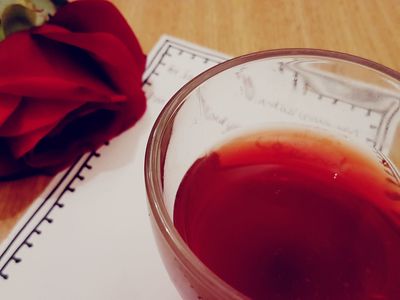
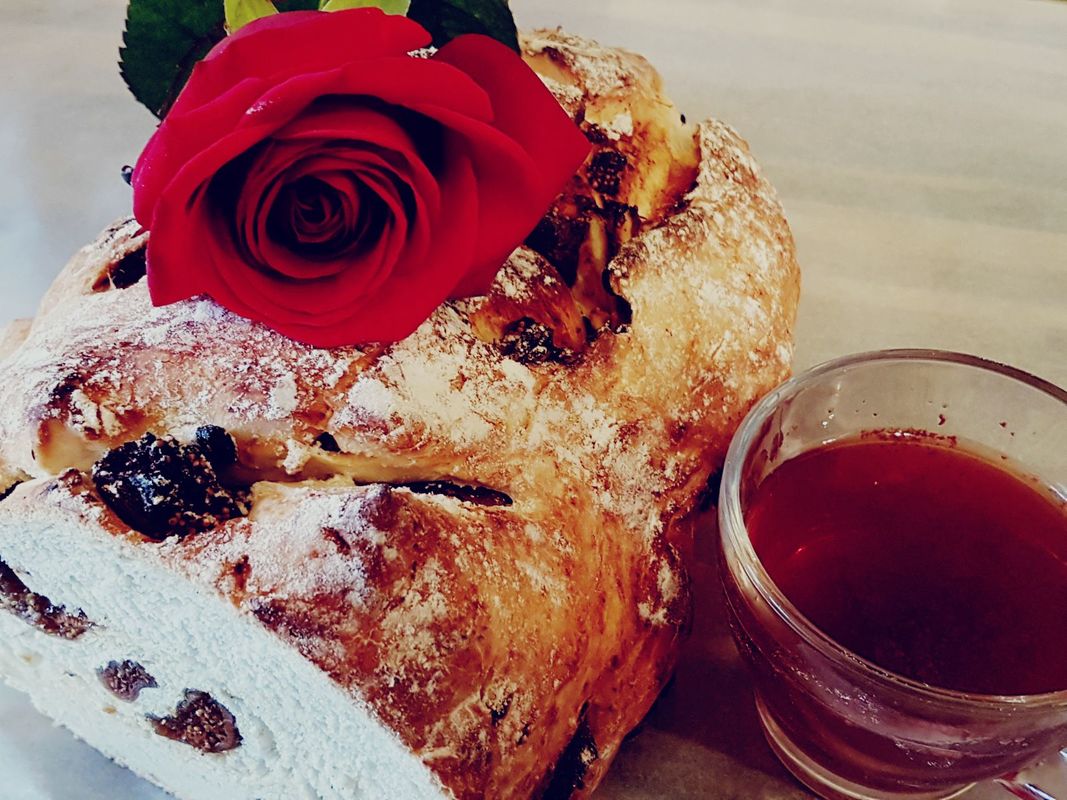



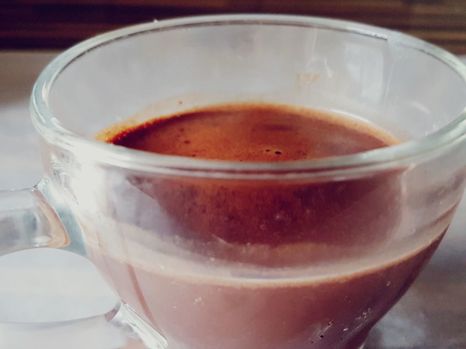

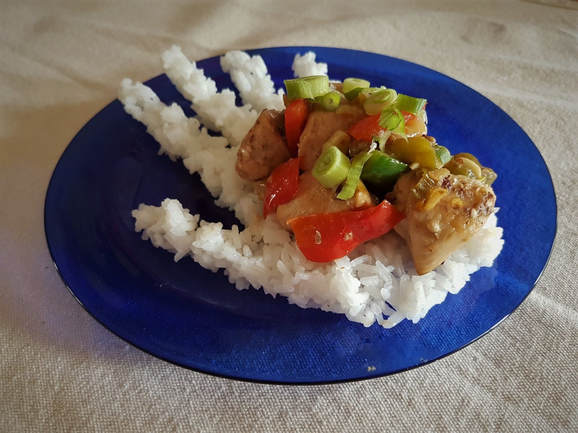
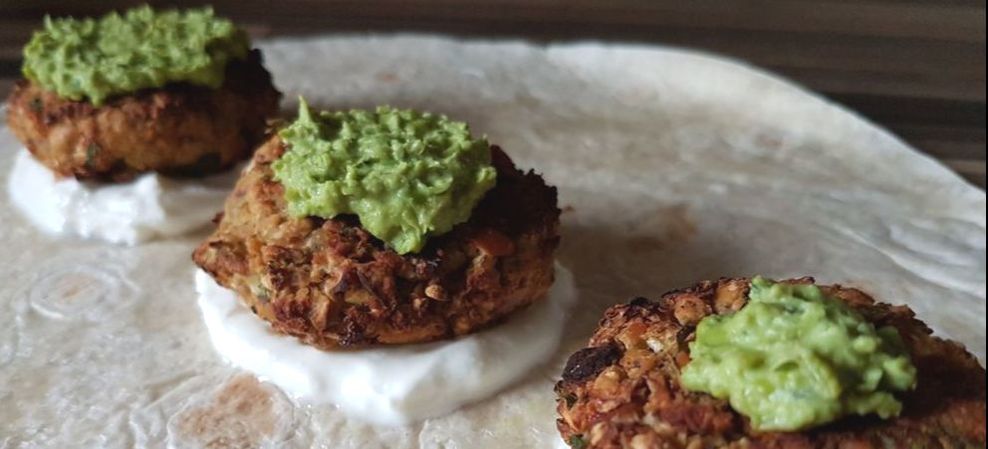
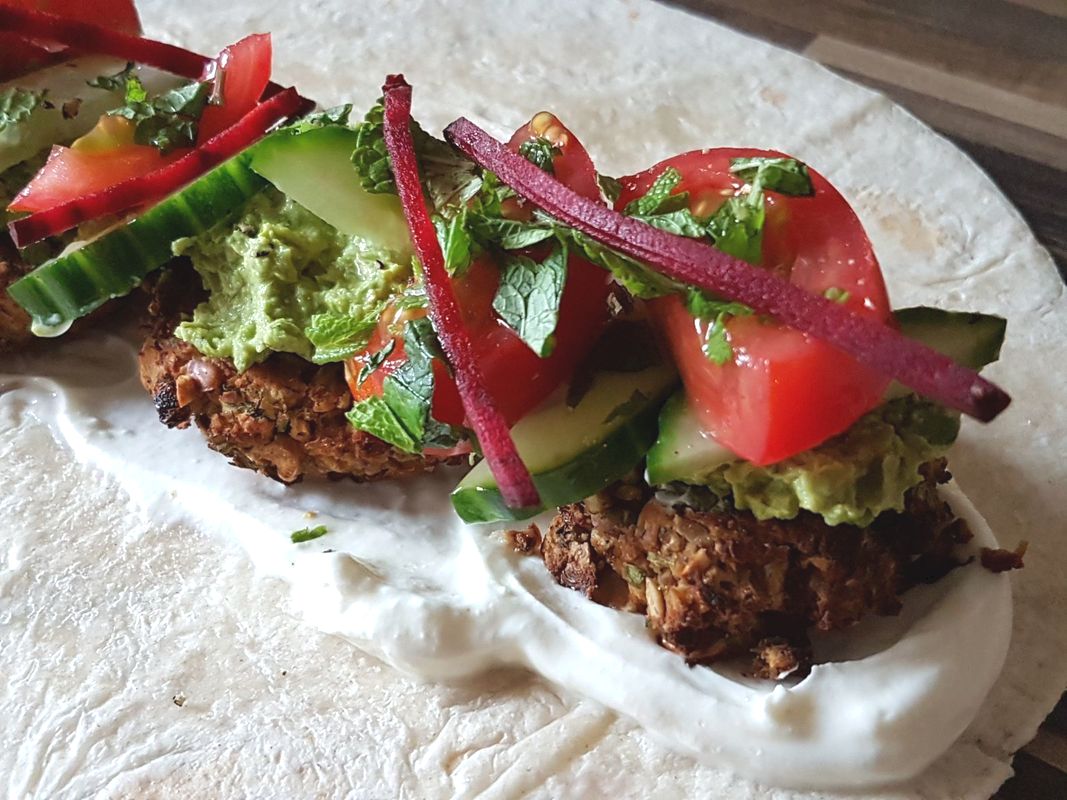

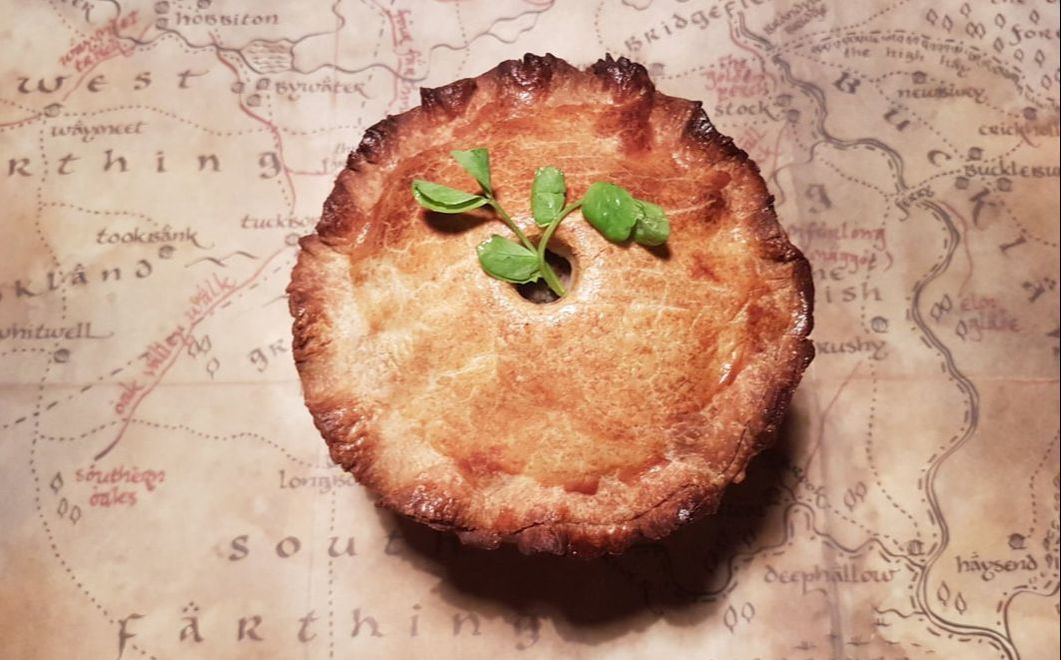


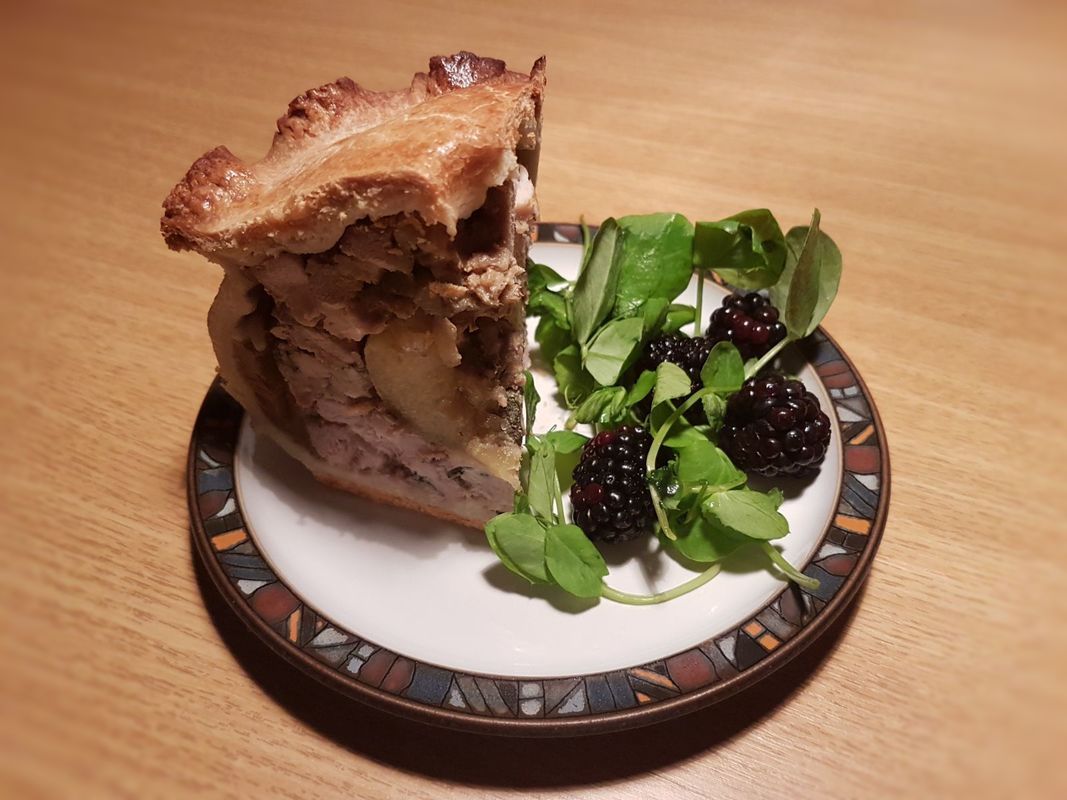
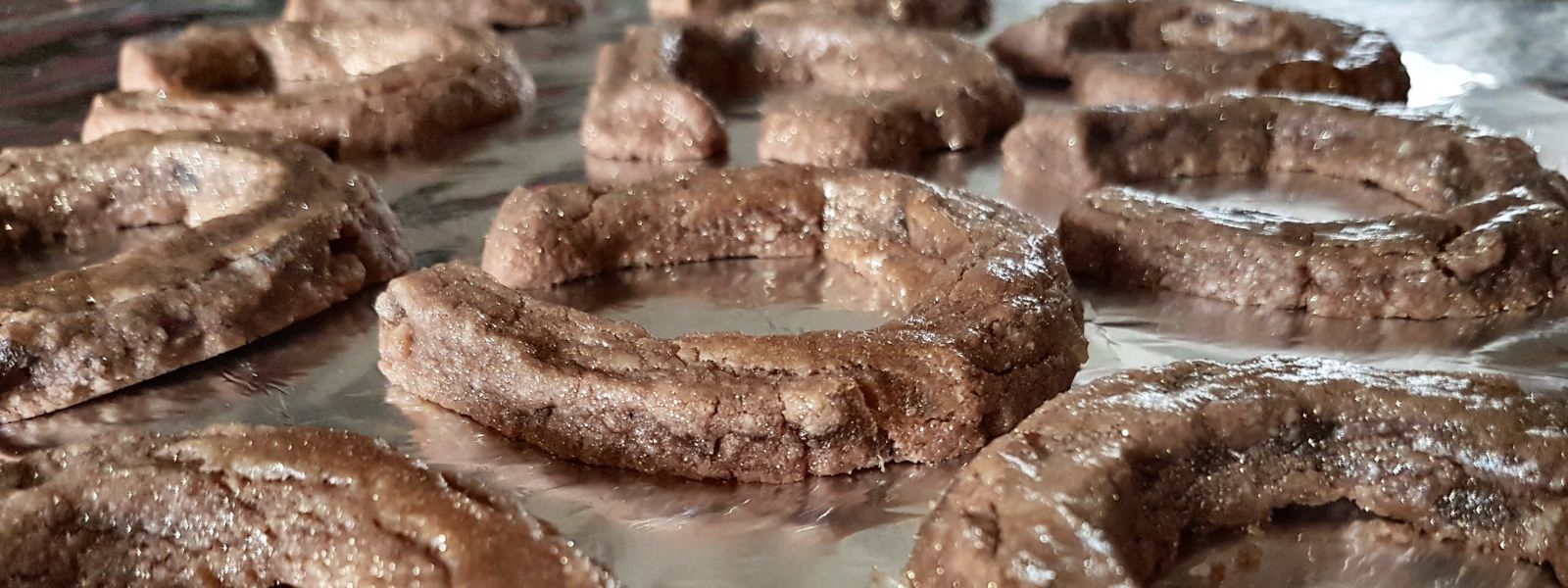






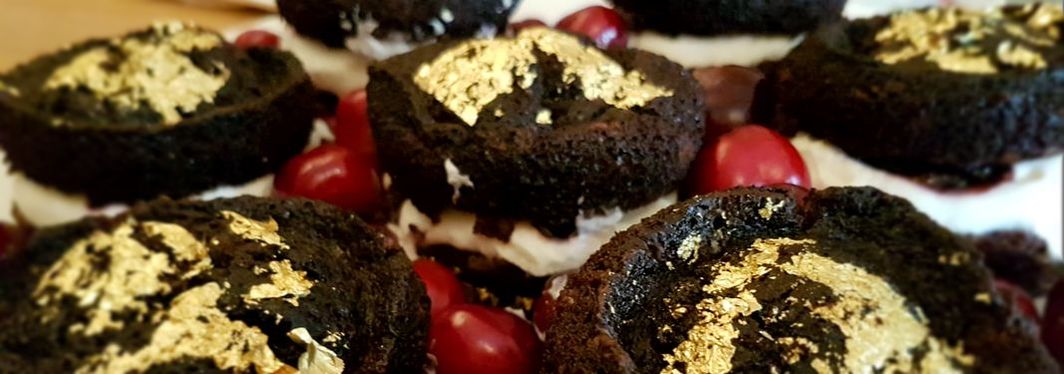

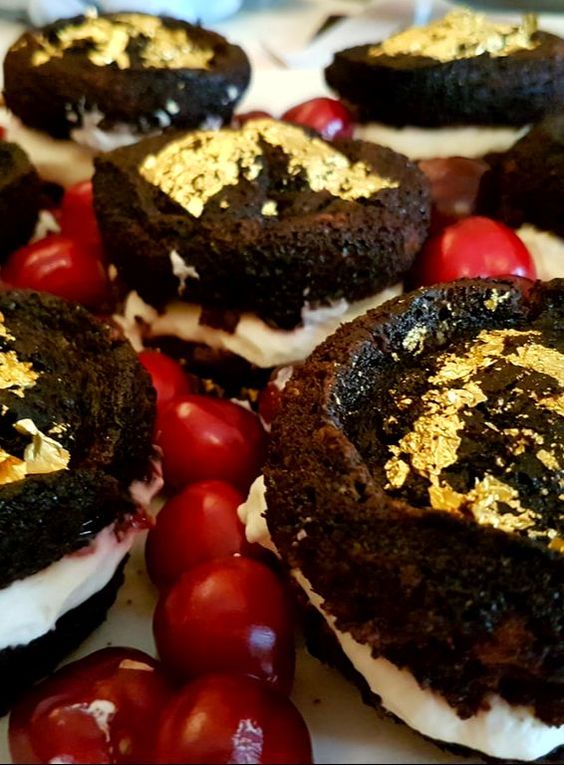



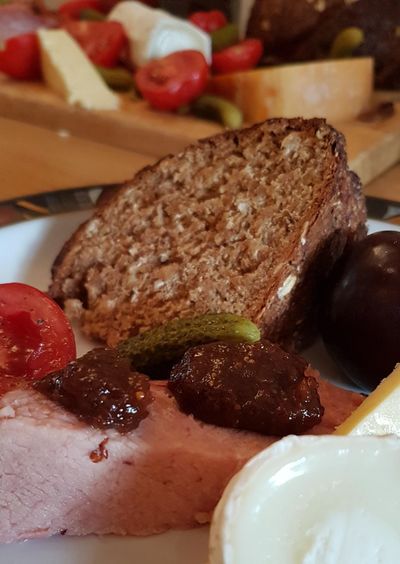

 RSS Feed
RSS Feed